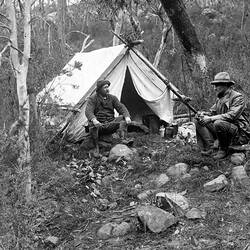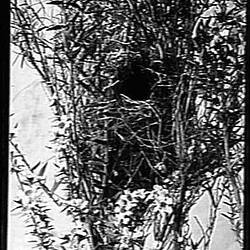EMU WREN (Stipiturus Malchurus, Shaw - 201)
Geographical Distribution - South Queensland, New South Wales, Victoria, South and West Australia, and Tasmania.
Nest - Oval in form (but that part which might be termed the true nest is perfectly round) placed on its side; the mouth very large (comparatively), taking up the whole of the upper part of the front. It is very shallow, so much so that if tilted slightly the eggs would roll out, they being almost upon a level with its edge. It is outwardly composed of grass and the young dry shoots of reeds; lined with fine grass, roots, and finally a very fine green moss. Very loosely put together, and requires to be moved very gently to prevent it from falling to pieces (Ramsay). Another example is oval, broadest at the base, with side entrance near the top; well built of grass, lycopodium, &c., with a few spiders' cocoons on the outside; inside lined with fine grass, &c.; usual situation, about a foot from the ground, in thick, short scrub. Dimensions: length, 4 ½ inches; breadth 3 inches; entrance, 1 inch across.
Eggs - Clutch, three, occasionally four; lengthened-oval in form; texture very fine; surface glossy; colour, pearly-white, spotted all over (like those of the Blue Wren, Malurus cyaneus, only redder), but sometimes with a large patch on the apex, and very few markings elsewhere, of rich reddish-chestnut. Eggs large compared with the size of the bird. Dimensions in inches of two pairs: A (1) .7 x .49, (2) .67 x .48; B (1) .67 x .54, (2) .66 x .49. (Plate 10.)
Observations - This remarkable little bird enjoys a somewhat extensive habitat, seeing it is found in favoured localities from Southern Queensland round to South-west Australia.
The Emu Wren is by no means a scarce bird, but as it frequents dense grass beds and rushes of low swampy districts, its nest is rarely discovered. I have looked for it in vain in places where I have observed the birds. When out with a party of field naturalists on 9th November, 1884, we came across young which apparently had just left the nest.
Gould found a nest containing three newly-hatched young in the neighbourhood of Recherche Bay, Tasmania. The nest, which he described as a small ball-shaped structure with rather a large opening on one side, was composed of grasses, lined with feathers, and artfully concealed in a tuft of grass.
Dr. Ramsay gives an interesting account of the finding of his first nest. He says: - 'I had for many days visited the swamps upon Long Island, where these birds are very plentiful, in hopes of finding them breeding, but it was not until the 25th September, 1861, that I succeeded in discovering a nest, although I had watched them for hours together for several days. While walking along the edge of the swamp, however, this day, I was agreeably surprised by disturbing a female, which flew from my feet out of an overhanging tuft of grass growing only a few yards from the water's edge. Upon lifting up the leaves of the grass, which had been bent down by the wind, I found its nest carefully concealed near the roots, and containing three eggs. As the bird did not fly far, but remained close by a small swamp-oak (Casuarina), I had a good opportunity of satisfying myself that it was the veritable Emu Wren. The eggs were, of course, quite warm, and within a few days of being hatched; this may account for the bird being so unwilling to leave the spot; for when I returned about five minutes afterwards the female was perched upon the same tuft of grass, and within a few inches from where I had taken the nest.'
Mr. G. E. Shepherd, Somerville, read some very interesting remarks on the 'Nidification of the Emu Wren' before the Field Naturalists' Club of Victoria, 14th December, 1897. He stated: - 'In the first place I may say that the birds are far from rare, though the eggs are exceedingly so - a fact, no doubt, due to the extreme difficulty experienced in finding the nest. In October, 1892, I found my first nest in the following curious manner. I had noticed a White Egret flying along the edge of the tide on the shore of Western Port Bay, and being anxious to secure the bird, a commenced stalking through the scrub fringing the fore-shore. Whilst so engaged I flushed an Emu Wren from a thick salonica bush, and dis-covered the nest, situated in the thickest part of the foliage, and containing three eggs, which were nearly hatched. Possessed of the knowledge thus obtained, I made repeated and persistent efforts to again find a nest, but without success until September, 1895, on the 14th of which month I succeeded in finding a nest containing two fresh eggs. This nest I also found accidentally through riding across a shallow swamp fringed with stunted tea-tree, from amongst which I saw the bird flutter, and after a short search discovered the nest. Two days afterwards I discovered another net in a patch of thick, low scrub. In this instance three eggs were taken, somewhat incubated, one of which broke when being blown.
'Owing to the absence of bush fires last summer the birds were more numerous this spring than for some years, hence I devoted all my spare time during the latter part of September and the whole of October to searching for their nests. On the 26th September I found a nest, in which were three eggs slightly incubated. The nest was placed at a height of eighteen inches from the ground among low dense scrub in a swampy locality. On the same date I also discovered the nest exhibited tonight, which the birds deserted, probably owing to my disturbing their nesting operations, as I saw the female within a few feet of the nest. This nest I have brought with as much surroundings as possible, and it will, I think, enable all interested to get a fairly good idea of the situations favoured by these birds for nesting. In this instance a space of two feet separated the nest from the ground, and in every instance coming under my notice the nests are situated among scrub, thick, low, and dense, and matted together with the wiry creeper as in the case of the nest exhibited. I subsequently found one nest and three fresh eggs; also, two nests, containing three and four eggs respectively, both the latter sets being nearly hatched; besides two others containing young birds.
'As all the nests were a considerable distance from my home, I had no opportunity of watching them for more than a brief period, which, however, enabled me to observe the female return to the nest on two occasions, and take her place upon the eggs. This she apparently does by 'backing' into the nest, hence her long tail sticks outward through the entrance and over her head, a conclusion forced upon me (even without the necessity of eye-witnessing) from the extreme length of the tail and size and shape of the nest. The eggs are somewhat large for the bird, and, like many other species, differ considerably in their markings. Nearly all those taken by me may be likened to the eggs of Malurus cyaneus, but some-what smaller. The nest is much more compact than the Blue Wren's, smaller, and much better finished, besides being more artfully concealed. As Gould has truly remarked, the bird's powers of flight are but feeble; hence it depends mainly upon its wonderful activity upon the ground as a means of escape from danger, and the dense undergrowth found in the localities it frequents.'
I have used Dr. Ramsay's description of the nest, and also have given the description of a typical nest which was kindly presented to me by Mr. Shepherd. The Western Port example is decidedly compact and well-built, and most resembles that of a Tit (Acanthiza). I have every confidence in Mr. Shepherd's identification. I have since been in the field with him, when he showed me similar nests built by Emu Wrens, one of which, by the way, contained an egg of the Narrow-tailed Bronze Cuckoo.
Breeding months September and probably to the end of the year.
The illustration of the 'Emu Wren's Nest' is taken from one situated near a bit of leptospermum scrub.
References
Transcribed from Archibald James Campbell. Nests and Eggs of Australian Birds, including the Geographical Distribution of the Species and Popular Observations Thereon, Pawson & Brailsford, Sheffield, England, 1900, pp. 214-217
More Information
-
Keywords
-
Authors
-
Contributors
-
Article types


